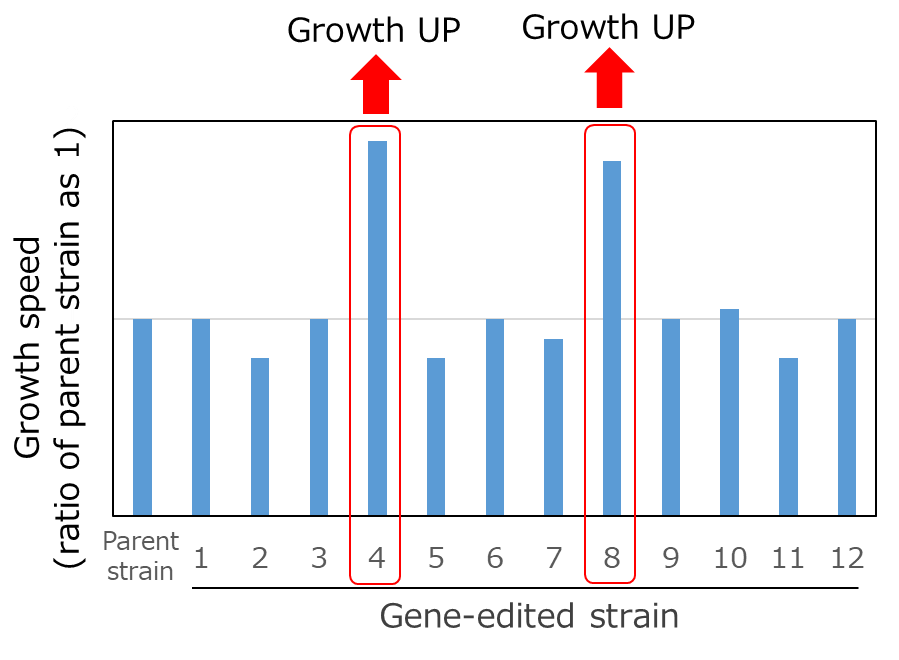Microsoft ends support for Internet Explorer on June 16, 2022.
We recommend using one of the browsers listed below.
- Microsoft Edge(Latest version)
- Mozilla Firefox(Latest version)
- Google Chrome(Latest version)
- Apple Safari(Latest version)
Please contact your browser provider for download and installation instructions.
February 9, 2023
NTT Corporation
Identification of genes that dramatically improve carbon dioxide absorption in algae
NTT Corporation (NTT, President & CEO: Akira Shimada) has established a method for selecting genes involved in carbon dioxide (CO2) absorption by algae and has succeeded in identifying genes that are expected to cause a revolutionary increase in CO2 absorption through genome editing technology*1.
1.Background
NTT and Regional Fish Institute, Ltd. (Regional Fish, President & CEO: Tadanori Umekawa) have been demonstrated a carbon dioxide conversion technology that reduces the amount of carbon dioxide (CO2) dissolved in the ocean by applying genome editing technologies to the food chain constituted of algae and fish and shellfish since 2021*2. This demonstration is an attempt to reduce CO2 emissions by using genome editing technology to improve both the function of algae to absorb CO2 (mainly bicarbonate ion: HCO3-) dissolved in seawater and the growth rate of fish and shellfish that feed on algae. NTT has been working to establish a genome-editing technology that improves the CO2 absorption of algae.
In previous studies on algae, genome editing has mainly focused on growth rate and oil production capacity with the aim of utilizing algae as food and fuel. On the other hand, in order to improve CO2 absorption through genome editing, which is the objective of this project, it was necessary to discover target genes that could be expected to change useful traits*3, since the genes involved in CO2 absorption are not clearly identified. This time, NTT has established a method for selecting genes involved in algal traits, and has succeeded in identifying genes that can be expected to drastically increase CO2 absorption by applying genome editing technology.
2.Identification of genes
Evaluation of traits based on the genes and their expression*4 in algae is made by creating mutants in which only one gene has been edited and using an environment in which the target trait prominently appears. It is conceivable that useful traits required for algae are increased CO2 absorption, increased oil production capacity, increased growth rate, and so on. By quantitatively evaluating which gene-edited mutants show the greatest change in these traits, candidate genes to be targeted for genome editing are selected.
For example, in the selection of genes involved in CO2 absorption, candidate genes that may be involved in CO2 uptake or photosynthetic reactions are targeted and their functions are enhanced or lost (Figure 1). In low CO2 environments, when a gene involved in CO2 uptake is enhanced or lost, the rate of CO2 uptake and organic matter production is significantly altered compared to the parental strain, and thus the gene can be determined as a CO2 uptake gene.
In the NTT's evaluation, gene-edited strains were created for 12 candidate target genes, and two genes were successfully selected that showed a significant increase in growth rate compared to the parental strain and were expected to cause a revolutionary increase in CO2 absorption (Figure 2).
 Figure 1 Selection method for genes involved in CO2 absorption
Figure 1 Selection method for genes involved in CO2 absorption
 Figure 2 Results of NTT's evaluation (12 genes)
Figure 2 Results of NTT's evaluation (12 genes)
3.Future perspective
In the future, we will conduct genome editing on the identified genes to evaluate CO2 absorption and also identify genes involved in other useful traits. In addition, organisms, including algae, have inherited a group of genes necessary for life support or metabolism during their evolutionary process, and the genes involved in CO2 absorption may be applicable to plants and other photosynthetic organisms. For this reason, we will also develop numerical data on the relationship between genes and trait changes in various organisms, and build a model to predict trait changes based on patterns and rules discovered by machine learning*5. These results will be used in the Green & Food Business*6 envisioned by NTT, Regional Fish, and other partners, and will contribute to reducing the environmental load and solving food shortages.
*1Genome editing technology intentionally cleaves specific nucleotide sequences in living organisms and alters the original functions by altering the nucleotide sequences that occur during the process of repairing the cleaved DNA. Unlike gene recombination technology that modifies functions by introducing genes from foreign sources, it is regarded as the same as conventional breeding because it only changes its own base sequence.
*2Press Release (Nov. 12, 2021): NTT and RFI to start demonstration experiment with the aim of reducing carbon dioxide in the ocean
https://group.ntt/en/newsrelease/2021/11/12/211112a.html
*3Trait is a characteristic or attribute of an organism.
*4Expression means the manifestation of genetic information as various biological functions through the synthesis of proteins in the body.
*5One of the technologies supporting artificial intelligence (AI), machine learning is a technique for automatically building computational models by discovering patterns and rules through repeated learning of large amounts of data.
*6This business produces and sells algae and seafood as envisioned by NTT and its partners, including Regional Fish.
Media Contact
NTT Information Network Laboratory Group
Planning Department, Public Relations Section
E-mail: nttrd-pr@ml.ntt.com
Information is current as of the date of issue of the individual press release.
Please be advised that information may be outdated after that point.
NTT STORY
WEB media that thinks about the future with NTT










